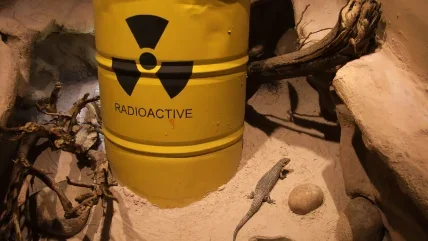
To secure its role as part of the future energy mix, the nuclear sector must continue to demonstrate how it will deal with the challenge of problematic legacy waste whilst developing safe, innovative technologies that reduce the cost of ongoing waste treatment and storage. All of this must be achieved within the parameters of environmental sustainability and financial viability.
When one thinks of innovative technology, our minds are often drawn to glamorous cutting-edge technologies such as robotics and AI, or groundbreaking products like the iPhone or Concorde. However, an important part of the innovation mix is making step-change improvements in processes and materials rather than making a gadget or a gizmo. Yet, these less conspicuous changes are essential in delivering the modifications required to further our shared vision of the nuclear industry’s safer, secure, and sustainable future.
One of the nuclear industry’s notable strengths lies in its collaborative approach to invention and innovation. Throughout its history, it has consistently showcased a remarkable capacity for bringing together industrial, academic, and government stakeholders to tackle some of the world’s most complex challenges. These innovators identify critical challenges and embark on the developing and optimising their solutions, even in the face of considerable risks and limited funding. One such example is the collaboration between Lucideon, an international materials technology company based in Staffordshire, UK, and NUVIA, a global nuclear engineering solutions provider.
The two businesses have forged a partnership that has quickly demonstrated the potential for Lucideon’s MIDAR®-Augmented Lower-cost Lower-carbon Encapsulation Technique (MALLETTM) as a long-term solution for the encapsulation of a variety of nuclear waste forms.
MIDAR® is a geopolymer technology that uses a low-temperature chemical reaction to consolidate aluminosilicates and form a robust body with high strength and chemical stability. The resulting material is suitable as an encapsulation and immobilisation agent by incorporating a solid or liquid waste stream into the inorganic solid matrix formed during the reaction. MIDAR® material is classified as an alkali-activated cement / geopolymer that relies on minimally processed natural materials or industrial by-products to achieve a significantly lower carbon footprint than Portland Cement (PC).
The technology brings together a unique blend of materials science, formulation technologies, and people expertise to provide the optimum performing geopolymer solution across a range of applications. It was developed in response to several nuclear industry waste disposal challenges, most significantly low percentage waste loading rates, or in some instances providing a solution where no viable route for disposal presently exists. The Lucideon/NUVIA collaboration has provided evidence to demonstrate MALLETTM as a superior method of managing intermediate and low-level waste streams, including oils, graphite, zeolites, sludges, and ashes.
The raw materials used are not reliant on scarce source materials such as Ground Granulated Blast-furnace Slag (GGBS) or Pulverised Fuel Ash (PFA), which are becoming more difficult to source to produce traditional nuclear waste cementation products.
MALLETTM increases loading rates through geopolymer formulations that fully encapsulate waste homogenously throughout the matrix, as shown in the images below:
Considering waste acceptance criteria for existing waste disposal routes, the resulting product was monitored
and characterised to provide qualitative evidence of performance. The results evidenced a final product which:
- Is fully set and free from cracking. The casting and curing procedures were done at room temperature (RT).
- Is dimensionally and physically stable at RT before and after leaching in various solutions including deionised water, buffer solution with high pH, and organic solvent.
- Is leach resistant (no release of strontium and caesium ions).
- Has strong compressive strength (>0.4 MPa, in many cases much greater) before and after leaching procedures.
- Has controlled porosity, voids, and homogeneity.
- Low viscosity allows the product to be pumped very easily directly into containers and enables application of pour-on/infiltration techniques.
- Generates a minimal exothermal reaction during the mixing, curing, and setting.
Irradiation testing was undertaken on a range of samples, demonstrating end-product integrity after 1 MGy total absorbed dose of gamma radiation from Cobolt 60.
This technical innovation is delivered by the geopolymer formulations and encapsulation methods. With existing encapsulation methods, relatively low levels of difficult-to- treat waste materials are encapsulated, usually at levels between 2% and 30% (the loading rate). This new approach has allowed the loading rate to increase to up to 70%. The potential savings from such an increase in loading are considerable.
The new encapsulation technique enables nuclear waste owners to process oils, graphite, zeolites, and sludges into a passive waste matrix that maximises waste loading and reduces overall waste disposal volumes, providing a simple batch process with little process variability and a significantly lower carbon footprint.
The encapsulation system has demonstrated how collaborative innovators can quickly develop solutions to complex challenges, supported by physical trials and proof of concept.
As a replacement to PC for nuclear waste encapsulation, the MIDAR®-Augmented Lower-cost Lower-carbon Encapsulation Technique has the potential to reduce the carbon impact of cementation processes, considerably reduce storage costs and provide security of supply. The flexibility of the developed formulations also allow the material to be adapted for broader nuclear applications such as stable, corrosion and fire-resistant structural materials for long-term storage.
Given the scale of the expected impact on nuclear decommissioning, it is not a question of whether this technology will be deployed – but who will prioritise the scale-up first and thus become the world leaders in advancing how we treat legacy and future wastes.
Foot note: Some of the activities described in this article were facilitated by Innovate UK Knowledge Transfer Network and were partially funded via the UK Research and Innovation (UKRI) Challenge Fund (through Innovate UK).
Authors: Tim Abbott, Lucideon Business Manager, Marta Fedorciuc-Onisa, Lucideon Senior Chemist and Adrian Davis-Johnson, NUVIA Head of Innovation






